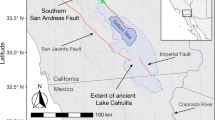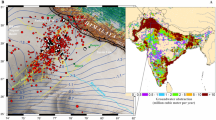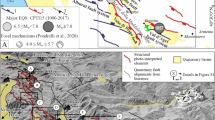Abstract
Groundwater use in California’s San Joaquin Valley exceeds replenishment of the aquifer, leading to substantial diminution of this resource1,2,3,4 and rapid subsidence of the valley floor5. The volume of groundwater lost over the past century and a half also represents a substantial reduction in mass and a large-scale unburdening of the lithosphere, with significant but unexplored potential impacts on crustal deformation and seismicity. Here we use vertical global positioning system measurements to show that a broad zone of rock uplift of up to 1–3 mm per year surrounds the southern San Joaquin Valley. The observed uplift matches well with predicted flexure from a simple elastic model of current rates of water-storage loss, most of which is caused by groundwater depletion3. The height of the adjacent central Coast Ranges and the Sierra Nevada is strongly seasonal and peaks during the dry late summer and autumn, out of phase with uplift of the valley floor during wetter months. Our results suggest that long-term and late-summer flexural uplift of the Coast Ranges reduce the effective normal stress resolved on the San Andreas Fault. This process brings the fault closer to failure, thereby providing a viable mechanism for observed seasonality in microseismicity at Parkfield6 and potentially affecting long-term seismicity rates for fault systems adjacent to the valley. We also infer that the observed contemporary uplift of the southern Sierra Nevada previously attributed to tectonic or mantle-derived forces7,8,9,10 is partly a consequence of human-caused groundwater depletion.
This is a preview of subscription content, access via your institution
Access options
Subscribe to this journal
Receive 51 print issues and online access
$199.00 per year
only $3.90 per issue
Buy this article
- Purchase on Springer Link
- Instant access to full article PDF
Prices may be subject to local taxes which are calculated during checkout



Similar content being viewed by others
References
Williamson, A. K., Prudic, D. E. & Swain, L. A. Ground-water flow in the Central Valley, California. US Geol. Surv. Prof. Pap. 1401-D. (1989)
Faunt, C. C. (ed.) Groundwater availability of the Central Valley aquifer, California. US Geol. Surv. Prof. Pap. 1766. (2009)
Famiglietti, J. S. et al. Satellites measure recent rates of groundwater depletion in California's Central Valley. Geophys. Res. Lett. 38, L03403 (2011)
Scanlon, B. R. et al. Groundwater depletion and sustainability of irrigation in the US High Plains and Central Valley. Proc. Natl Acad. Sci. USA 109, 9320–9325 (2012)
Poland, J. F., Lofgren, B. E., Ireland, R. L. & Pugh, R. G. Land subsidence in the San Joaquin Valley, California, as of 1972. US Geol. Surv. Prof. Pap. 437-H. (1975)
Christiansen, L. B., Hurwitz, S. & Ingebritsen, S. E. Annual modulation of seismicity along the San Andreas Fault near Parkfield, CA. Geophys. Res. Lett. 34, L04306 (2007)
Fay, N. P., Bennett, R. A. & Hreinsdóttir, S. Contemporary vertical velocity of the central Basin and Range and uplift of the southern Sierra Nevada. Geophys. Res. Lett. 35, L20309 (2008)
Bennett, R. A., Fay, N. P., Hreinsdóttir, S., Chase, C. & Zandt, G. Increasing long-wavelength relief across the southeastern flank of the Sierra Nevada, California. Earth Planet. Sci. Lett. 287, 255–264 (2009)
Hammond, W. C., Blewitt, G., Li, Z., Plag, H. P. & Kreemer, C. Contemporary uplift of the Sierra Nevada, western United States, from GPS and InSAR measurements. Geology 40, 667–670 (2012)
Saleeby, J., Saleeby, Z. & Le Pourhiet, L. Epeirogenic transients related to mantle lithosphere removal in the southern Sierra Nevada region, California: Part II. Implications of rock uplift and basin subsidence relations. Geosphere 9, 394–425 (2013)
Holzer, T. L. Elastic expansion of the lithosphere caused by groundwater depletion. J. Geophys. Res. 84, 4689–4698 (1979)
van Dam, T. et al. Crustal displacements due to continental water loading. Geophys. Res. Lett. 28, 651–654 (2001)
Jiang, Y., Dixon, T. H. & Wdowinski, S. Accelerating uplift in the North Atlantic region as an indicator of ice loss. Nature Geosci. 3, 404–407 (2010)
Nof, R. N. et al. Rising of the lowest place on Earth due to Dead Sea water-level drop: evidence from SAR interferometry and GPS. J. Geophys. Res. 117, B05412 (2012)
Fu, Y. & Freymueller, J. T. Seasonal and long-term vertical deformation in the Nepal Himalaya constrained by GPS and GRACE measurements. J. Geophys. Res. 117, B03407 (2012)
Heki, K. Snow load and seasonal variation of earthquake occurrence in Japan. Earth Planet. Sci. Lett. 207, 159–164 (2003)
Luttrell, K., Sandwell, D., Smith-Konter, B., Bills, B. & Bock, Y. Modulation of the earthquake cycle at the southern San Andreas fault by lake loading. J. Geophys. Res. 112, B08411 (2007)
Bettinelli, P. et al. Seasonal variations of seismicity and geodetic strain in the Himalaya induced by surface hydrology. Earth Planet. Sci. Lett. 266, 332–344 (2008)
González, P. J., Tiampo, K. F., Palano, M., Cannavó, F. & Fernández, J. The 2011 Lorca earthquake slip distribution controlled by groundwater crustal unloading. Nature Geosci. 5, 821–825 (2012)
Ben-Zion, Y. & Allam, A. A. Seasonal thermoelastic strain and postseismic effects in Parkfield borehole dilatometers. Earth Planet. Sci. Lett. 379, 120–126 (2013)
Christensen, M. N. Late Cenozoic crustal movements in the Sierra Nevada of California. Geol. Soc. Am. Bull. 77, 163–182 (1966)
Small, E. E. & Anderson, R. S. Geomorphically driven late Cenozoic rock uplift in the Sierra Nevada, California. Science 270, 277–281 (1995)
Le Pourhiet, L. & Saleeby, J. Lithospheric convective instability could induce creep along part of the San Andreas fault. Geology 41, 999–1002 (2013)
Blewitt, G., Kreemer, C., Hammond, W. C. & Goldfarb, J. M. Terrestrial reference frame NA12 for crustal deformation studies in North America. J. Geodyn. 72, 11–24 (2013)
Altamimi, Z., Collilieux, X. & Métivier, L. ITRF2008: an improved solution of the international terrestrial reference frame. J. Geod. 85, 457–473 (2011)
Schmidt, D. A. & Bürgmann, R. Time-dependent land uplift and subsidence in the Santa Clara valley, California, from a large interferometric synthetic aperture radar data set. J. Geophys. Res. 108, 2416 (2003)
Argus, D., Fu, Y. & Landerer, F. Seasonal variation in total water storage in California inferred from GPS observations of vertical land motion. Geophys. Res. Lett. 41, 1971–1980 (2014)
Dettinger, M. D. & Cayan, D. R. Large-scale atmospheric forcing of recent trends toward early snowmelt runoff in California. J. Clim. 8, 606–623 (1995)
California Department of Water Resources. California water plan update 2005. Volume 1: Strategic Plan. Dep. Water Res. Bull. 160–05. (2005)
Jeager, J., Cook, N. & Zimmerman, R. Fundamentals of Rock Mechanics 4th edn (Blackwell, 2007)
Zumberge, J. F., Heflin, M. B., Jefferson, D. C., Watkins, M. M. & Webb, F. H. Precise point positioning for the efficient and robust analysis of GPS data from large networks. J. Geophys. Res. 102, 5005–5017 (1997)
Boehm, J., Niell, A., Tregoning, P. & Schuh, H. Global mapping function (GMF): a new empirical mapping function based on numerical weather model data. Geophys. Res. Lett. 33, L07304 (2006)
Bar-Sever, Y. E., Kroger, P. M. & Borjesson, J. A. Estimating horizontal gradients of tropospheric path delay with a single GPS receiver. J. Geophys. Res. 103, 5019–5035 (1998)
Scherneck, H.-G. A parametrized solid earth tide model and ocean tide loading effects for global geodetic baseline measurements. Geophys. J. Int. 106, 677–694 (1991)
Blewitt, G. Carrier phase ambiguity resolution for the Global Positioning System applied to geodetic baselines up to 2000 km. J. Geophys. Res. 94, 10187–10283 (1989)
Bertiger, W. et al. Single receiver phase ambiguity resolution with GPS data. J. Geod. 84, 327–337 (2010)
Altamimi, Z., Collilieux, X. & Métivier, L. ITRF2008: an improved solution of the international terrestrial reference frame. J. Geodesy 85, 457–473 (2011)
Rebischung, P. et al. IGS08: The IGS realization of ITRF2008. GPS Solut. 16, 483–494 (2012)
Harris, R. A. Stress triggers, stress shadows, and implications for seismic hazard. J. Geophys. Res. 103, 24347–24358 (1998)
Stein, R. S. & Ekstrom, G. E. Seismicity and geometry of a 110-km long blind thrust fault. 2. Synthesis of the 1982-1985 California earthquake sequence. J. Geophys. Res. 97, 4865–4883 (1992)
Toda, S. & Stein, R. S. Response of the San Andreas fault to the 1983 Coalinga-Nuñez earthquakes: an application of interaction-based probabilities. J. Geophys. Res. 107, 2126 (2002)
Acknowledgements
Funding for this work comes from NSF EarthScope award number EAR-1252210 to G.B. and W.C.H. GPS data were collected using the EarthScope Plate Boundary Observatory, SCIGN, BARGEN, BARD, CORS and IGS networks. We are particularly grateful to UNAVCO for operating the vast majority of GPS stations used in this project. GPS data were processed using the GIPSY OASIS II software and data products from the Jet Propulsion Laboratory.
Author information
Authors and Affiliations
Contributions
C.B.A. and P.A. performed the analysis and wrote the paper. W.C.H. and G.B. analysed and processed the GPS data. All authors contributed to the interpretations and preparation of the final manuscript.
Corresponding author
Ethics declarations
Competing interests
The authors declare no competing financial interests.
Extended data figures and tables
Extended Data Figure 1 Vertical GPS data.
Map of vertical uplift rates spanning California and the western Great Basin, including stations within the Central Valley groundwater basin. El., elevation; GPS vert., GPS vertical velocity.
Extended Data Figure 2 GPS time series.
The top panel shows a histogram of the duration of GPS time series. 96% are longer than 4.0 years. The bottom panel shows a histogram of the percentage of complete time series. 92% are greater than 80% complete.
Extended Data Figure 3 GPS time series.
Example vertical GPS time series for stations P056 and P570. Blue dots are daily vertical position solutions, red lines are the model estimated to represent the time series. The station P056 is in the southern Central Valley near Porterville, California. The station P570 is near Weldon, California, east of Lake Isabella.
Extended Data Figure 4 Stress profiles from distributed line loads of an elastic half-space.
a, Model setup, where  is the line-load rate, a is the load half-width, and θ1 and θ2 measure the angle downward from the positive x axis to any point (x0, z0) at depth.
is the line-load rate, a is the load half-width, and θ1 and θ2 measure the angle downward from the positive x axis to any point (x0, z0) at depth.  and
and  give the stress rates and Coulomb stress rates, respectively. b, c, Stress rates at depths of 5 km (b) and 15 km (c) calculated from the long-term rate of unloading over the San Joaquin Valley with a = 30 km. Vertical dashed lines labelled SAF and CF represent the locations of the San Andreas Fault and the Coalinga blind thrust faults (including the Nuñez fault), respectively, relative to the load centre. Black and coloured lines indicate stress components and Coulomb stress changes, respectively. The blue curves labelled N show Coulomb stress calculations for favourably oriented faults with a 65° dip, representing the Nuñez fault. For the red curve representing the Coalinga fault (CF), the calculations are performed using a dip of 30° for unfavourably oriented faults. The green curve represents unclamping stress for vertically dipping faults such as the San Andreas Fault. d, e, Stress changes at depths of 5 km and 15 km from seasonal (peak-to-peak) load changes over the San Joaquin River Basin with a = 100 km (full width of 200 km). The position of the San Andreas Fault and Coalinga faults reflects displacement of the load centre by 30 km relative to the long-term load. Varying the load half-width and the load centre by ±10 km has only a small impact (<0.5 kPa) on the resolved seasonal stress changes on the faults.
give the stress rates and Coulomb stress rates, respectively. b, c, Stress rates at depths of 5 km (b) and 15 km (c) calculated from the long-term rate of unloading over the San Joaquin Valley with a = 30 km. Vertical dashed lines labelled SAF and CF represent the locations of the San Andreas Fault and the Coalinga blind thrust faults (including the Nuñez fault), respectively, relative to the load centre. Black and coloured lines indicate stress components and Coulomb stress changes, respectively. The blue curves labelled N show Coulomb stress calculations for favourably oriented faults with a 65° dip, representing the Nuñez fault. For the red curve representing the Coalinga fault (CF), the calculations are performed using a dip of 30° for unfavourably oriented faults. The green curve represents unclamping stress for vertically dipping faults such as the San Andreas Fault. d, e, Stress changes at depths of 5 km and 15 km from seasonal (peak-to-peak) load changes over the San Joaquin River Basin with a = 100 km (full width of 200 km). The position of the San Andreas Fault and Coalinga faults reflects displacement of the load centre by 30 km relative to the long-term load. Varying the load half-width and the load centre by ±10 km has only a small impact (<0.5 kPa) on the resolved seasonal stress changes on the faults.
Source data
Rights and permissions
About this article
Cite this article
Amos, C., Audet, P., Hammond, W. et al. Uplift and seismicity driven by groundwater depletion in central California. Nature 509, 483–486 (2014). https://doi.org/10.1038/nature13275
Received:
Accepted:
Published:
Issue Date:
DOI: https://doi.org/10.1038/nature13275
This article is cited by
-
Using geodetic measurements derived terrestrial water storage to investigate the characteristics of drought in Yunnan, China
GPS Solutions (2024)
-
Subsurface carbon dioxide and hydrogen storage for a sustainable energy future
Nature Reviews Earth & Environment (2023)
-
Creep-dilatancy development at a transform plate boundary
Nature Communications (2022)
-
Space-time monitoring of groundwater fluctuations with passive seismic interferometry
Nature Communications (2022)
-
Deformation mechanism and model of river valley contraction of the Xiluodu reservoir, China
Environmental Earth Sciences (2022)
Comments
By submitting a comment you agree to abide by our Terms and Community Guidelines. If you find something abusive or that does not comply with our terms or guidelines please flag it as inappropriate.



